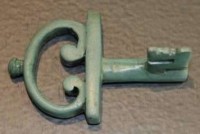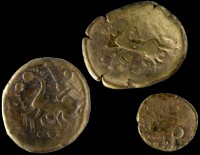 In 2010, archaeologists excavating sites along the route of a new high speed rail line unearthed an exceptional number of Gallic coins and artifacts under communal farmland in the town of Bassing, Lorraine, in northeastern France. The National Institute for Preventive Archaeology (INRAP) announced the find at a press conference in Metz on Thursday, November 29th.
In 2010, archaeologists excavating sites along the route of a new high speed rail line unearthed an exceptional number of Gallic coins and artifacts under communal farmland in the town of Bassing, Lorraine, in northeastern France. The National Institute for Preventive Archaeology (INRAP) announced the find at a press conference in Metz on Thursday, November 29th.
The 3.5 hectare site revealed evidence of continuous occupation from 200 B.C. to 800 A.D., including the remains of a Gallic aristocrat’s home, a villa from the Gallo-Roman period and several early medieval buildings. The earliest structure, an enclosure with a large home and farm within, was built between 150 and 120 B.C. and appears to have been occupied until 14 A.D. The wealth and status of its occupants are testified to by the structures and by the expensive artifacts found, among them a gold ring, bracelets, cobalt blue glass jewelry, Baltic amber and 132 fibulae (ancient safety pins used to close cloaks and garments). Some of the fibulae were imported and others produced locally. The large number suggests the site was a center of trade. This is confirmed by the remains of many Italian amphorae which probably held imported wine, a luxury only the elite of Gaulish society could afford.
bracelets, cobalt blue glass jewelry, Baltic amber and 132 fibulae (ancient safety pins used to close cloaks and garments). Some of the fibulae were imported and others produced locally. The large number suggests the site was a center of trade. This is confirmed by the remains of many Italian amphorae which probably held imported wine, a luxury only the elite of Gaulish society could afford.
 Remains of both Gallic and Roman military artifacts suggest the homeowners weren’t just involved in farming and trade. Fragments of chariots, a battle axe, arrowheads, metallic trimmings of uniforms, nails from hobnailed shoes, cavalry harnesses, several mouthpieces from war horns and one Roman legionary dagger were found on the site, but there is no evidence that life on the property was interrupted or debased by war. In all likelihood, the artifacts identify the elites who lived there as members of the Médiomatrique tribe who populated the area and supported the Roman invasion. Much of the Gallic nobility participated in the fight on the Roman side, sending their own warriors to fight alongside Caesar’s.
Remains of both Gallic and Roman military artifacts suggest the homeowners weren’t just involved in farming and trade. Fragments of chariots, a battle axe, arrowheads, metallic trimmings of uniforms, nails from hobnailed shoes, cavalry harnesses, several mouthpieces from war horns and one Roman legionary dagger were found on the site, but there is no evidence that life on the property was interrupted or debased by war. In all likelihood, the artifacts identify the elites who lived there as members of the Médiomatrique tribe who populated the area and supported the Roman invasion. Much of the Gallic nobility participated in the fight on the Roman side, sending their own warriors to fight alongside Caesar’s.
 The vast amount of cash found on the property was also probably destined for military use. A total of 1165 Gaulish coins from the 1st century B.C., 1,111 silver quinarii (small coins valued at half a denarius or five asses, hence “quinarius”), three gold staters and 51 bronze pieces, were unearthed scattered throughout the site. Some of them are Gallic in style and iconography. Others are rough imitations of Gallo-Roman quinarii (notable for Gallic elements like torques added to Roman profiles) of a kind made between 40 and 30 B.C. when Roman money was in short supply, so Gauls made local versions which could be used in the trade between Rome and Gaul. The total value of the Bassing coins could pay a year and a half’s salary for a legionary at the dawn of the empire.
The vast amount of cash found on the property was also probably destined for military use. A total of 1165 Gaulish coins from the 1st century B.C., 1,111 silver quinarii (small coins valued at half a denarius or five asses, hence “quinarius”), three gold staters and 51 bronze pieces, were unearthed scattered throughout the site. Some of them are Gallic in style and iconography. Others are rough imitations of Gallo-Roman quinarii (notable for Gallic elements like torques added to Roman profiles) of a kind made between 40 and 30 B.C. when Roman money was in short supply, so Gauls made local versions which could be used in the trade between Rome and Gaul. The total value of the Bassing coins could pay a year and a half’s salary for a legionary at the dawn of the empire.
The silver coins come from different areas of Gaul.
74% of the lot come from the East Central Gaul and belongs to Sequani of Besançon, the Lingons Langres, the Aedui Bibracte or Autun. 14% are from the people of the Loire Valley, 7% from the Remi of Reims (Gaul Belgium) and 3% Arverni of Clermont-Ferrand. Finally, a few copies belong to Ségusiaves, people located near Lyon.
![]() This is an exceptional number of coins for a Gallic site. Only 400 coins total have ever been discovered in the major Gaulish town of Alesia, where Julius Caesar famously defeated Vercigetorix in the final battle of the Gallic Wars in 52 B.C., and they were mainly bronze coins and cheaper denominations in regular circulation. Silver was primarily reserved for use by the elite to secure their military power.
This is an exceptional number of coins for a Gallic site. Only 400 coins total have ever been discovered in the major Gaulish town of Alesia, where Julius Caesar famously defeated Vercigetorix in the final battle of the Gallic Wars in 52 B.C., and they were mainly bronze coins and cheaper denominations in regular circulation. Silver was primarily reserved for use by the elite to secure their military power.
Although found scattered, this cache was probably buried in one group between 40 and 20 B.C. and then scattered by ploughs which have been churning the soil since the Middle Ages.
I cannot even decipher the other names. Who was ‘Atevla’ or ‘Vlatos’ ? It is a bit desturbing that you can actually buy some of these coins for paper money. Atevla, apparently, was one of the tribes and Vlatos their ruler, in fact -according to the internetz- ‘vlatos’ means ‘ruler’. More and more, however, I get the impression that his name was ‘Atevla’ and he is the one depicted. Did they know about him in Rome ?
Cf. also:
http://www.finds.org.uk/CCI/tribe.php?tribe=ATEVLA
http://www.heinrich-tischner.de/22-sp/1sprach/kelt/akelt/uv.htm
These seem to be indeed Remi coins. Check again the “Gallic-coins-minted-between-60-and-20-BC1.jpg”. Apart from atevla the vlatos/ulatos, there is for instance in the bottom right hand corner a coin with “ANDECOM” whereas in the bottom left hand corner there is one with what could be deciphered as “ICCO”. Are these the ones referred to in Gaius’ commentarii ? There is also an “ARIVO” (Ariovistus ?). — Very confusing.
Gaius Iulius Caesar in Commentarii de bello Gallico (Liber II) on the Remi people …
“As he [CAESAR] arrived there unexpectedly and sooner than any one anticipated, the Remi, who are the nearest of the Belgae to [Celtic] Gaul, sent to him ICCIUS and ANDECOMBOGIUS, [two of] the principal persons of the state, as their embassadors: to tell him that they surrendered themselves and all their possessions to the protection and disposal of the Roman people: and that they had neither combined with the rest of the Belgae, nor entered into any confederacy against the Roman people: and were prepared to give hostages, to obey his commands, to receive him into their towns, and to aid him with corn and other things; that all the rest of the Belgae were in arms; and that the Germans, who dwell on this side of the Rhine, had joined themselves to them; and that so great was the infatuation of them all, that they could not restrain even the Suessiones, their own brethren and kinsmen, who enjoy the same rights, and the, same laws, and who have one government and one magistracy [in common] with themselves, from uniting with them.”
“Eo cum de improviso celeriusque omnium opinione venisset, Remi, qui proximi Galliae ex Belgis sunt, ad eum legatos Iccium et Andebrogium, primos civitatis, miserunt, qui dicerent se suaque omnia in fidem atque potestatem populi Romani permittere, neque se cum reliquis Belgis consensisse neque contra populum Romanum coniurasse, paratosque esse et obsides dare et imperata facere et oppidis recipere et frumento ceterisque rebus iuvare; reliquos omnes Belgas in armis esse, Germanosque qui cis Rhenum incolant sese cum his coniunxisse, tantumque esse eorum omnium furorem ut ne Suessiones quidem, fratres consanguineosque suos, qui eodem iure et isdem legibus utantur, unum imperium unumque magistratum cum ipsis habeant, deterrere potuelint quin cum iis consentirent.”